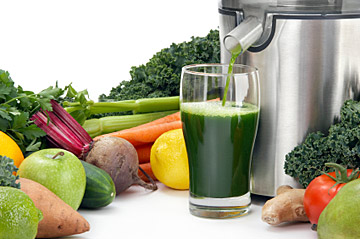The Art of Juicing (and Pureeing)
By Claudia Anrig, DC
We know that the process of cooking vegetables destroys valuable micronutrients by altering their shape and chemical composition; but is it possible to eat enough raw vegetables to get the nutrition your body needs? That's where juicing can be valuable.
Why Juicing?
The benefits of juicing are wide and varied, beginning with the fact that you can consume the most beneficial amounts of vegetables efficiently while absorbing all of the available nutrients. A habitually poor diet will eventually make your body less efficient at absorbing the maximum available nutrients in the foods you consume. By juicing vegetables, it's almost like they've been pre-digested, so you can receive the most nutrients available.
Additionally, we all know how difficult it can be to get children in particular to eat their vegetables; providing them in an easy-to-drink, flavorful juice can help with that problem. Another recommendation is to freeze the juice into popsicles. Although freezing the juice will damage some of the nutrients, the benefits (especially compared to the alternative – not eating any vegetables) are still really high.
Juicer Basics
The first step for many families is buying a juicer. There are a numerous options, ranging in price from $100 to thousands of dollars. A high-quality juicer will be an extractor that extracts the flesh from the vegetables and then spins the juice out.
 Clean-up time is an important consideration. Some machines will actually allow pulp to get into little nooks and crannies; if this happens, clean-up time is doubled and sometimes tripled because that pulp will rot if not removed and will require practically dismantling the machine to clean it. An extensive cleaning time could discourage you from juicing on a regular basis. A high-quality juicer should take no more than 5 minutes per use to clean.
Clean-up time is an important consideration. Some machines will actually allow pulp to get into little nooks and crannies; if this happens, clean-up time is doubled and sometimes tripled because that pulp will rot if not removed and will require practically dismantling the machine to clean it. An extensive cleaning time could discourage you from juicing on a regular basis. A high-quality juicer should take no more than 5 minutes per use to clean.
The other consideration is speed. We all think that faster is better; when it comes to juicing, this is not the case. Inexpensive juicers are typically centrifugal and will spin at really high speeds to extract the juice. I do not recommend juicers that act more like blenders because the heat generated by the higher RPMs can actually damage the valuable nutrients, almost like cooking. Additionally, low-speed / single-gear machines will create a lot less foam, making the juice more palatable.
What to Juice?
After you've decided which juicer to purchase, the most important decision is what to actually put in the juicer. Things to consider: the greener the better; remember that fruit is high glycemic and can raise blood sugar; and never supplement your juice with bottled juice, as this defeats the purpose.
Buy organic whenever possible and look for local farmers or co-ops that grow their products seasonally. And don't be surprised at the amount of vegetables it is going to take to create the one small glass of raw juice.
If you're new to juicing, the best vegetables to start with are celery, fennel or cucumbers. These are easy to digest and tolerate. Once you've become accustomed to juicing you can begin to add red-leaf, green-leaf or romaine lettuce, endive, escarole or spinach,and then cabbage or bok choy. Remember that cabbage can be a digestive irritant, so don't use too much at a time.

